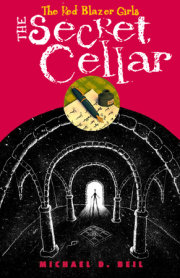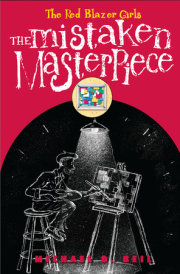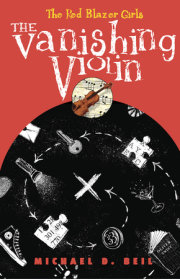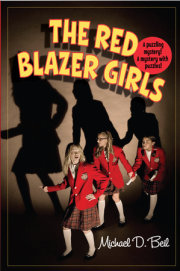Chapter 1
The first time I saw Clarence Nockwood, the conductor aboard the Lake Erie Shoreliner, he was standing on the green-carpeted platform of New York’s Grand Central Terminal, adjusting the hands of his pocket watch. When he was satisfied that it matched the time shown on the station clock exactly, he looked up to see my mother, baby sister, and me in a desperate race against that clock to catch his train. Clarence was very particular about his Elgin watch, and some might say that he was obsessed with punctuality, but to him, being on time was a matter of pride. The Shoreliner, one of the famous express trains of the 1930s and ’40s that carried passengers in under twenty hours from New York to Chicago--a distance of 960 miles--was never as fast, famous, or luxurious as the Twentieth Century Limited or the Broadway Limited, but it was well known for being on time. If the departure was scheduled for one-seventeen, the Shoreliner departed at one-seventeen--“on the dot,” as Clarence would say.
“All aboard!” cried Clarence as he slipped his watch into his vest pocket. “Lake Erie Shoreliner for Chicago! First stop, Albany! All aboard!”
My mother, dressed in a simple but stylish suit and modest heels, was running as fast as she could down the platform toward him, with my two-year-old sister, Jessica, cradled in one arm and a small suitcase in her other hand. A few steps behind them, I struggled to keep up, wrestling with a piece of luggage nearly twice my size.
“Wait, wait for us!” Mother shouted.
Grinning, Clarence helped us aboard and instructed a porter to help with our bags.
“Thank you . . . thank you,” Mother managed to say between breaths. “I thought for sure we’d missed it.”
Clarence checked the time on his pocket watch again and smiled at her. “Made it with thirty seconds to spare. You folks going to Chicago?”
“We’re going home to Ashtabula. My dad is the captain of a ship, the Point Pelee,” I bragged. “Have you ever heard of it?”
“I’m afraid not,” admitted Clarence. “I don’t know much about boats and such. But if you want to know anything about trains, I’m your man.”
“It’s not a boat; it’s a ship,” I said. Knowing the difference between boats and ships was serious business in the Shipley household.
“And I’m sure it’s a fine ship, too. Now, if you’ll excuse me a second. Hold on, folks. Here we go!” announced Clarence, and at exactly seventeen minutes past one on May 22, 1938, the Lake Erie Shoreliner chugged out of Grand Central Terminal in New York City and began to snake its way north along the Hudson River.
The Great Depression was still going strong in 1938, but the Shipley family was “making do,” as Mother was fond of saying. We were more fortunate than most because Father--Captain Charles Shipley, that is--still had his job, but as a ship’s captain he was away at sea for weeks, and sometimes months, at a time. Normally, we would not have been able to afford a train trip to New York City, but Mother had recently inherited a small amount of money and a few pieces of not-very-valuable jewelry from a distant relative who lived there, and the relative’s lawyer, a fussy little man whose suit smelled of coffee and burnt toast, had insisted that she travel to New York in person to pick it up and sign the necessary papers. And so, Mother, Jessica, and I made the trip without Father, whose ship was, at that very moment, steaming east past the Colchester Reef lighthouse in western Lake Erie.
Unlike the Twentieth Century Limited, the Shoreliner wasn’t quite an “all-sleeper” train. There were a few coach seats available near the onboard barber shop at the back of the club car, but Mother had decided to splurge (just a little), buying “section” tickets. They weren’t as comfortable or as private as a drawing room, but they were much less expensive.
“You never know when we might need that extra money,” she explained as we settled into our seats. “I know it’s a little snug, but it’s only for a little while. We’ll be back home before you know it, and you’ll get to sleep in your own bed later tonight.”
“Can I go back to the observation car?” I asked. “I want to watch the boats on the river.”
“Just be careful. Promise? Why don’t you take your new sketchbook and draw me a picture? Here, take this, in case you want to buy something to drink.” She handed me a nickel, which I tucked deep into my front pocket. “And make sure you’re back here in time for dinner. I’m going to treat you to a special meal tonight.”
Until my sister came along, I had been an only child for eight years, so I was used to entertaining myself. I started out by wandering forward and peeking inside the combination mail and baggage car, which was directly behind the locomotive. A young porter bumped into me as I stood there wondering how I could get into the cab of the locomotive.
“You lost, young fella? Everything’s back thataway,” he said, pointing over my shoulder. “Just mail and baggage up here.”
“Oh. Thanks,” I said, sneaking one last peek into the car before turning around and heading down the narrow passageway of the two 8-1-2 sleeper cars at the front of the train. Like all sleeper cars, they got their name from the way they were set up. In this case, there were eight sections, one drawing room, and two compartments in each car. Our section was in the second of the two cars, and the curtain was still open when I went past. Mother didn’t notice--her nose was already buried in Gone with the Wind, which she had borrowed from the Ashtabula library before our trip and was reading for the second time in less than two weeks.
Next came the dining car, its tables all set with glistening china, crystal, and silver, waiting for the dinner crowd. As I left that scene behind, I stepped into the vestibule of the first of three roomette cars, and paused to admire the view down the shoulder-width hallway that seemed to go on forever. Each car had twenty-two doors leading to twenty-two ingeniously designed miniature rooms, and after walking past sixty-six doors, I stepped into the bright lights of the club car. Although we were barely out of the station, it was already bustling, with all but two of the shiny leather seats filled and the bartender busy shaking drinks. The air was blue with cigarette smoke as men and women sipped cocktails, chatting and laughing noisily, and ignored me completely. It was my first time in a bar, and I lingered for a few minutes, mesmerized, before ducking into the winding passages of the three 4-4-2 sleeper cars, where the more well-to-do travelers were likely to be found. (The four bedrooms, four compartments, and two drawing rooms were different widths, giving the hallway twists and turns.)
And finally, at the back, where the caboose would be on a freight train, was the observation car. In addition to the observation area and lounge, it also contained the Commodore Perry suite--the most expensive accommodations on the Shoreliner. I roamed all the way to the rear of the car, past businessmen who glanced over their newspapers at me and excited young couples marveling at the sights of the city, and dropped myself into a backward-facing seat where I could watch the Hudson slide by as the train accelerated, rocking gently on the tracks.
In the weeks before the trip to New York, I had saved up a few pennies, and at the first newsstand I found, I bought the latest copies of my favorite comic books--The Shadow and Dick Tracy, along with a new one, Tailspin Tommy. I didn’t tell Mother (even though it was my money, I just couldn’t bear the thought of the disappointed look on her face when she saw what I had chosen to spend it on) and stuck them inside the cover of my sketchbook, saving them for a quiet, relaxing time when I could sit back and really savor every word and colored panel without feeling guilty.
Before I even had a chance to discover what evil lurked in the hearts of men, though, a tugboat towing a barge up the river caught my attention, so I fished a stub of pencil out of my shirt pocket and opened my sketchpad. I leafed past the drawings of the Manhattan skyscrapers I had made from our hotel room on Fifty-First Street and stopped at a clean sheet. Working quickly as the train rumbled north, I rough-sketched the scene, managing to get just the outline of the tugboat and a few details down before the train tracks followed a bend in the river and the scene disappeared from view.
“Hey, that’s pretty good,” said an unfamiliar voice. A girl’s voice.
I spun around and there she was, leaning over my seat, spying on me. Instinctively, I closed my sketchbook. I didn’t like showing my drawings to anyone, especially not to nosy girls I didn’t even know.
She pointed out the window as the train went around another bend, bringing the tugboat back into view. “Look! You can see it again. Open up your sketchbook! Hurry!”
But I just stared at her, gripping the pad tightly in my hand just in case she had some idea of snatching it from me. Girls are like that.
“What’s the matter? Don’t you want to draw anymore? You’re really quite talented. I peeked at the drawings you made of the city. Don’t you just love New York? I can’t imagine living anywhere else. We live on Fifth Avenue, right across from Central Park. Did you visit the park? You really should have, you know. Did you know that it’s more than eight hundred acres?”
I’m pretty sure my jaw was hanging open as I listened to the girl, who had obviously been spying on me from the moment I’d sat down.
“Do you always spy on people?” I asked when she finally took a breath. “My mother says that’s rude.”
The girl grinned at me, and her eyes, which perfectly matched her emerald-green cotton jumper, twinkled mischievously behind the mop of dark curls that framed her face. “So does mine. But I don’t care. I can’t help it if I want to know about people. How are you supposed to learn about them if you don’t pay attention to them? Close attention.”
I didn’t know how to answer that. One thing I knew for sure: she wasn’t like any of the girls back home in Ashtabula.
While I sat there not saying a word, the girl kept right on talking, so fast that I had trouble keeping up. “I was the first one aboard, and I watched everyone else get on,” she said. “We’re staying in the Commodore Perry suite at the front of this car. We usually take the Twentieth Century Limited when we go to Chicago. It’s so much more luxurious, don’t you think?” Unfazed by my silence, she took a breath and continued. “I remember you--you were the last one to board, thirty seconds before departure time. Mother says I have a photographic memory. You were with your mother and your baby sister. Your mother was wearing a green dress and a black coat. And a hat with a purple--well, more like lavender, actually--flower on the left side. I’m Ellie, by the way. Ellie Strasbourg, like the city in France. Last month, I turned one whole decade old. What’s your name? Wait, let me guess . . . it’s . . . Herbert.”
“No!”
“Woodrow?”
“No.”
“Calvin?”
“No. It’s Henry,” I answered before she tried Grover or Abraham or Chester, or some other president’s name.
“Henry what?”
“Henry Shipley. That was my great-grandfather’s name, too.”
She reached her hand over the seat to shake mine. “Hi, Henry Shipley. It is a pleasure to make your acquaintance.” As I looked around the car uncomfortably, certain that everyone was watching and laughing at me, she did just about the worst thing I could have imagined: she abandoned her seat and took the one next to me. “Where are you going?” she asked as I stood to leave, still gripping my sketchpad. I had to get out of there before she did something really embarrassing.
“I, um, have to go,” I mumbled.
“Don’t be silly,” she said. “We’re on a train. Where could you possibly have to go? I just want someone to talk to. I’m not going to bite you. Although Father says that I may talk someone to death one day. Isn’t that just the funniest thing ever? The only other children on this train are much too young to be interesting, so I’m afraid you’re stuck with me--at least until Erie. That’s where we’re getting off. We’re going to Conneaut Lake Park to ride the Blue Streak. Have you heard of it?”
I sat back down, suddenly impressed. Of course I had heard of the Blue Streak. Every kid for miles around had heard of it and dreamed of riding it. It was the newest, biggest, fastest, and scariest roller coaster in the whole country, and its grand opening was scheduled for May 23, the very next day.
“You’re taking the train all the way from New York just to ride the Blue Streak? Boy, you’re lucky. I doubt if I’ll ever get to ride it, and I only live a few miles away. Mother says amusement parks are a waste of money.”
“Oh. Sorry. I hope I didn’t sound like I was bragging. It’s--my daddy is friends with Mr. Vettel, the man who designed it, and he invited us. I know--I’ll ask him if you can come, too!”
“I don’t think so. My parents would never let me go. And besides, my father is coming home tonight. He’s been away on his ship for weeks.”
“Is he an explorer?” Ellie asked. “Like Sir Francis Drake? Or Robert Peary? We learned about them in school. Don’t you just love learning about history?”
Not especially, I thought, suddenly picturing myself staring at the clock in history class, willing the hands to move faster. “He’s not an explorer; he’s the captain of a ship that carries iron ore, the Point Pelee. I’d rather learn about science any day. I’m going to be a naval architect and design the biggest, fastest, and best ships ever. You have to know lots about science to do that.”
Ellie hopped up and down in her seat. “You can come to New York and work for my daddy! He builds ships! It will be so much fun!”
“I don’t know . . . it takes a long time to learn everything you need to know. I have to go to college first, and then . . .”
“I’m going to be a famous detective,” said Ellie. “Just like Nancy Drew. Have you read any of her stories? No, I don’t suppose you have. Mother says it’s not a proper occupation for a lady, but I don’t care.”
Copyright © 2014 by Michael D. Beil. All rights reserved. No part of this excerpt may be reproduced or reprinted without permission in writing from the publisher.








